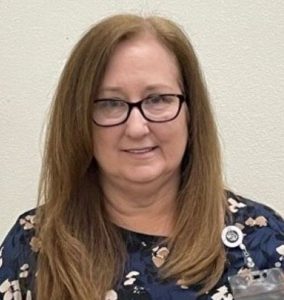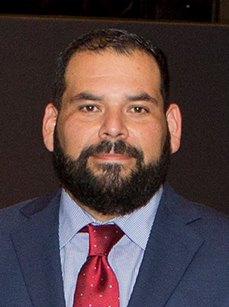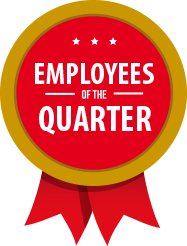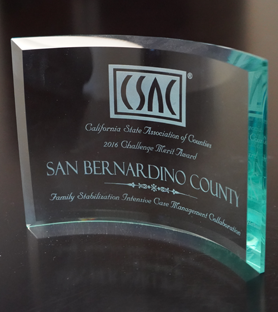NACo
National Association of Counties (NACo) recognizes groundbreaking county government programs throughout the nation through its Achievement Awards. The Achievement Awards is an annual non-competitive awards program with 18 different categories that reflect the vast, comprehensive services counties provide including children and youth, criminal justice, county administration, planning, information technology, health and more.
Getting Ahead:
The Transitional Assistance Department’s (TAD’s) “Getting Ahead” cohort is a facilitated learning experience designed for San Bernardino County Subsidized Employment Program (known as the Work Experience [WEX] program) participants. The “Getting Ahead” cohort provides TAD WEX participants with an understanding of the causes and impacts of poverty, assistance with identifying and seeking needed resources, and the ability to discover new tools for solving problems. Cohort participants, known as investigators, use life experiences as the context for learning about poverty and developing problem-solving skills to help build productive futures. The cohort is delivered over a 20-week period through a series of 10 modules, and uses the “Getting Ahead in a Just Gettin’ by World” curriculum as the basis for investigating poverty within individuals, institutions, and communities. “Getting Ahead” encourages investigators to make positive life changes, improve mental health and well-being, develop social support, and set personal and professional goals. Since the inception of the first cohort in 2018, over 50 participants have completed or are currently participating in the program (26 completed 24 in process). Participants report the critical thinking skills obtained in the cohort have led to improved parenting skills, new educational interests, and the courage to leave abusive relationships.
Housing Disability and Advocacy Program (HDAP):
San Bernardino County Transitional Assistance Department (TAD) in partnership with the Community Development and Housing Agency (CDHA), implemented the Housing and Disability Advocacy Program (HDAP) in 2018, which works to identify and serve disabled homeless individuals by providing immediate bridge and permanent housing, case management and legal assistance/representation for disability-income program applications. HDAP consist of four elements:
- Outreach using current infrastructures to identify participants and enroll in the program.
- Case management assists participants with various needs and navigating complex systems to obtain assistance from other county and community-based social service programs.
- Disability Advocacy assists with completing the necessary paperwork to submit a complete application for long-term disability benefits.
- Housing Assistance works directly with the participant to enter into bridge housing and shift the participant into permanent housing with ongoing support.
San Bernardino’s HDAP has successfully engaged and transitioned 40 chronically homeless, disabled individuals into permanent housing in 2019. 70% of HDAP participants enter into Permanent Supportive Housing (PSH) within 90 days of program enrollment, with approximately half of this group entering into PSH in less than 30 days. On average, chronically homeless persons receiving non-HDAP services can take approximately six or more months to enter into stable permanent housing.
Proactive Texting Outreach:
San Bernardino County Transitional Assistance Department (TAD) offers proactive text messaging as a measure to avoid benefit disruption on California Work Opportunities and Responsibilities to Kids (CalWORKs) (cash aid) and/or CalFresh (California’s Supplemental Nutrition Assistance Program [SNAP]) cases. Proactive texting is an individualized texting approach, aimed to decrease preventable case discontinuances and case churn. Enrollment in the program prevents customer benefit disruption due to missed appointments or incomplete/missing Semi-Annual Reports (SARs) and Re-evaluations/Re-certifications (REs/RCs). This greatly reduces staff workload from processing reapplications and/or initiating non-compliance actions. Customers receiving proactive / individualized texting alerts experienced a decrease in benefit disruptions of 34% for SAR, and 14% for RE/RC related issues. To increase enrollment, San Bernardino developed a Proactive Texting Outreach program which focused efforts on contacting customers with a SAR due in two months, not previously opted-in to proactive texting. Eligibility and clerical staff, as well as Welfare-to-Work (WTW) Work Experience (WEX) staff were trained to complete outreach and assist with enrollment. Staff explained the features and benefits of the program, and assisted with enrollment, if requested.
Sanction Reengagement Program:
In 2019, San Bernardino County Transitional Assistance Department (TAD) implemented a Welfare-to-Work (WTW) Sanction Reengagement program. This program was in part an effort to assist sanctioned and removed-from-aid persons to return to aid, thereby increasing family stability and improving child well-being. TAD designed the Sanction Reengagement program with the following objectives in mind:
- Reduce the number of WTW sanctioned individuals,
- Utilize various incentives to promote sanction cures, and
- Keep customers engaged in WTW after completion of sanction cure.
A pilot of the Sanction Reengagement program was implemented in four of the 18 district offices. The remaining 14 offices maintained established business processes. Within the pilot offices, TAD realized a decrease of 42.7% in sanction customers versus a decrease of 13% within the remaining district offices.
Supervised Field Experience (SFE):
In 2018, San Bernardino County Transitional Assistance Department (TAD) in partnership with the county Performance, Education & Resource Centers (PERC) redesigned the Eligibility Worker (EW) and Employment Services Specialist (ESS) onboarding classes and implemented a Supervised Field Experience (SFE) component for new trainees. SFE provides structured on-the-job training every Friday for the length of the onboarding class. Trainees report to his/her assigned district office, are greeted by a predesignated supervisor and mentor/coach, and complete standardized activities prepared by PERC, such as review documents, observe interviews, and narrate case actions. Implementing SFE has well-equipped new employees by enabling them to receive practical hands-on experience during the learning process allowing them to “connect the dots” between classroom instruction and on-the-job training. It facilitates the transition from being in the learning/training environment to working in the district office. This has created a comprehensive system where retention of new employees has improved by over 16%, trainee satisfaction has risen, and new staff have a clearer understanding of what to expect in the work setting.
Proactive Texting Program:
San Bernardino County Transitional Assistance Department (TAD) offers proactive text messaging, issued by the Consortium IV (C-IV) system, as a measure to avoid negative action to California Work Opportunities and Responsibilities to Kids (CalWORKs) (cash aid) and CalFresh (California’s Supplemental Nutrition Assistance Program [SNAP]) cases. This program helps customers stay informed of the status of Semi-Annual Reports (SARs) and Re Evaluations / Recertifications (REs/RCs), as well as information regarding benefit amounts. Proactive texting also improves customer service by notifying the customer information is needed to avoid adverse action.
The most prominent reason for case discontinuance is failure to return the SAR or complete an RE/RC. TAD and C-IV developed proactive text notifications to reduce case churn caused by missed SARs and RE/RCs. The objectives of the proactive texting notifications were to:
- Ensure customers were informed of needed material during the SAR and RE/RC process,
- Increase customer awareness of case actions, and
- Decrease the amount of case churn.
Of those who opted-in to the texting feature, this program resulted in a decrease in terminations for not completing a SAR or RE/RC. Discontinuances for not providing a complete SAR decreased by as much as 34%, and discontinuances for not completing an RE/RC decreased 14.25%.
HS Time Study Enhancement and EMACS Integration:
Time Study Reports track time worked by individual employees on various social service programs. Completed reports submitted to the California Department of Social Services (CDSS) are used to apportion costs to all welfare programs. It is essential that Time Studies are complete and accurate to ensure proper funding for the administration of all Human Services (HS) programs. HS departments complete Time Studies using the same application software. Users are expected to complete a Time Study entry daily and/or cyclically.
San Bernardino County payroll system, Employee Management and Compensation system (EMACS) application integrates the business processes of Human Resources (HR) and Auditor-Controller/Treasurer/Tax Collector (ATC) to manage employees, their pay and benefits. Integration of EMACS within the Time Study System application facilitates accurate time accounting and creates transparency between both applications. This promotes staff accountability for correct entry and guarantees timely report submission. When combined, this allows for better time management, resulting in effective customer service delivery. Integration also ensures correct Time Study reporting and subsequent program allocation.
CalHEERS Ticket Portal:
The implementation of the Affordable Care Act (ACA) in 2014 required County Eligibility Workers (EWs) to utilize the California Healthcare Eligibility Enrollment and Retention System (CalHEERS) to determine eligibility for health care programs.
When expected eligibility results are not received, the case must be reviewed and a trouble ticket submitted to the CalHEERS Service Portal. Although San Bernardino County currently hosts 669 CalHEERS users, counties were each granted two access accounts for submitting tickets. Therefore, it was determined a standardized process and location to submit and track tickets was critical for efficient and timely staff communication without overburdening the CalHEERS Support Team.
San Bernardino County Program Development Division (PDD) worked with the Transitional Assistance Department (TAD), and Information, Technology, and Support Division (ITSD) to create a Microsoft SharePoint site to submit, triage, and track CalHEERS tickets for system issues. This site allows County policy staff to review and troubleshoot issues prior to escalation to the CalHEERS Service Portal to ensure only system issues are forwarded. In addition, this site allows the County to track escalated tickets awaiting resolution, review or re-open closed tickets as needed and identify widespread issues impacting users.
CalFresh Outreach:
The San Bernardino County Transitional Assistance Department (TAD) has actively participated in and assisted with facilitating outreach events that promote the CalFresh program (California’s Supplemental Nutrition Assistance Program (SNAP)). Participation in these events is a key component in ensuring that county residents who are experiencing food instability are aware of the CalFresh program and how they can apply for benefits. Outreach events offer TAD an opportunity to go into local communities and work with other community based organizations (CBOs) whose goals align with TAD’s mission of enhancing county residents’ quality of life. TAD collaborates with these CBOs throughout the county to provide informational presentations that cover the CalFresh program. During outreach events, TAD staff provide a general overview of the program, clarify common misconceptions, assist customers with applying for benefits and offer CBOs and other partners electronic application technical assistance. Participation in outreach events has contributed to San Bernardino County’s high Program Reach Index (PRI) and provided a source of food security for numerous county residents.
Streamlined Application Process:
The San Bernardino County Transitional Assistance Department (TAD) developed and implemented a Streamlined Application Process for customers applying for assistance in person at local TAD offices. This process was developed to improve overall customer service by increasing the efficiency and accuracy of the intake application process through the removal of unnecessary steps, updating forms, use of available technology and ensuring the use of consistent intake procedures among all San Bernardino County TAD offices.
The Streamlined Application Process revised and updated existing practices utilized by TAD staff when customers applied for assistance. These revised procedures enhanced the movement of the customer in the application process, while easing the burden on staff to accurately make benefit determinations, which provided a more satisfying and timely customer experience.
Self-Service Options Campaign:
The County of San Bernardino Transitional Assistance Department (TAD) offers a variety of self-service options to customers. Self-service options enable customers to access case information and complete case actions at their convenience – online, via telephone, or in person. To promote self-service options, TAD developed a department wide marketing campaign which included staff and customer facing materials ranging from a customer brochure and tutorial to staff training videos.
The objectives of the campaign were to:
- Ensure customers were educated on the benefits of using self-service options.
- Increase self-service options enrollment.
- Increase satisfaction and overall customer service experience.
- Provide staff the information necessary to confidently and consistently present self-service options to customers.
- Decrease churn, call volume, and staff workload. The most effective tool developed was a video tutorial to inform customers about four of TAD’s most beneficial self-service options:
- C4Yourself.com®,
- Electronic Notifications (e-Notifications),
- Texting Notifications, and
- Visual Interactive Voice Response (VIVR).
The yearlong campaign resulted in San Bernardino County having the highest number of self-service options enrollment of 39 Consortium counties that participated in self-service options. Within the county, there was a 78.5% increase in self-service options enrollment and a 10.04% decrease in calls to the Customer Service Center (CSC).
Supervisor Academy:
The Transitional Assistance Department (TAD) Supervisor Academy is a formalized training developed for newly hired supervisors prior to reporting to their assigned offices. Standardized training previously did not exist, resulting in information and experiences varying from person to person. The Academy provides a structured curriculum, mentoring, and learning environment to ensure consistency for the newly hired supervisors. The Academy is delivered in 22 modules which focus on supervision and management basics. The program works to foster individual professional development and increase knowledge of the department at a management level, with the goal of promoting greater productivity, and improving the overall retention rate within this classification. Since the inception of the TAD Supervisor Academy in 2016, a total of 199 supervisors have participated. The 2016 attrition rate was 9.9% and, once the program implemented, the attrition rate fell to 5.6% in 2017 (a 44% decrease). Of the 199 supervisors who attended, 35 were newly hired and 164 were regular status supervisors. Participants have reported taking on new duties in their current position, and have enhanced their supervisory skills.
Inmate Medi-Cal Enrollment:
Studies have shown, inmates with active health coverage at discharge have improved continuity of care, well-being, and reduced recidivism. San Bernardino County has taken a unique approach to this challenge by expanding Medi-Cal (California’s Medicaid program) application services to inmates by partnering the County Transitional Assistance and Sheriff’s Departments with Loma Linda University School of Public Health. Together we have implemented a Medi-Cal outreach and enrollment process specifically targeting jail populations throughout the region. Efforts include trained on-site staff providing application assistance to inmates, coordinating and centralizing eligibility, correctional, and CBO staff to streamline the process, and enhanced communication with inmates to facilitate successful Medi-Cal enrollment. By implementing this program, San Bernardino County has obtained 1,999 Medi-Cal applications from county inmates. Of that number, 1,789 have been successfully enrolled into an active Medi-Cal case, a 90% success rate
Mobile Fresh:
San Bernardino County Transitional Assistance Department (TAD), in collaboration with the Family Service Association (FSA), is increasing fresh food accessibility to Supplemental Nutrition Assistance Program (SNAP, known as CalFresh in California) recipients via “Mobile Fresh”, a renovated commuter bus that sells fresh produce and dry goods. Mobile Fresh provides the selection and freshness of a Farmer’s market to neighborhoods that lack fresh food accessibility. Produce and dry goods sold by Mobile Fresh costs 20 to 30 percent less than products sold in grocery stores. Mobile Fresh currently visits three TAD district offices per month to serve TAD customers. Electronic Benefit Transfer (EBT) payments are accepted at Mobile Fresh, benefiting those who may not have cash allocated for food purposes. TAD provides 25% off coupons to customers as an incentive to use CalFresh benefits at Mobile Fresh. The 25% discount is fully covered by FSA. Sales via EBT have been consistent since Mobile Fresh began visiting TAD district offices in April 2016, and plans are currently being developed to expand Mobile Fresh to other TAD locations.
Visual Interactive Voice Response (VIVR):
San Bernardino County Transitional Assistance Department, in collaboration with the California Statewide Automated Welfare System (SAWS) Consortium IV (C-IV), is increasing customer case access by offering Visual Interactive Voice Response (VIVR) through the existing Customer Service Center (CSC). Transitional Assistance is committed to providing customers with a variety of self-service options that allow them to use his/her smartphone to access case information and reach eligibility staff. Visual IVR provides recipient customers with a mobile web-based solution for navigating the IVR automated phone system and making certain changes to their cases instead of navigating voice-based menus and remaining on a telephone call. Visual IVR is customer friendly, flexible, efficient, and supports the County’s Green Initiative to reduce environment impact by elimination of unnecessary car travel. Visual IVR assists with expediting information requested from a customer and reduces the need for repeat customer contact or return office visits.
Interactive Voice Response (IVR) Biometric Voice Print (BVP) Log In:
San Bernardino County Transitional Assistance Department (TAD) implemented a centralized Customer Service Center (CSC) call center which incorporated an Interactive Voice Response (IVR) system. The IVR system allows customers the ability to access automated case information 24 hours a day for the following programs: Transitional Assistance for Needy Families (TANF), also known as California Work Opportunity and Responsibility to Kids (CalWORKs), Supplemental Nutrition Assistance Program (SNAP), also known as CalFresh, and Health Care Programs/Medi-Cal (Medicaid). The IVR system initially allowed customers to self-authenticate themselves using his/her case number and an assigned Personal Identification Number (PIN). This authentication process provides access to case information quickly; however, customers often forget their PIN, requiring a separate process to have it reset, or be placed in a holding queue until a CSC Eligibility Worker (EW) can assist. In September 2015, TAD added the Biometric Voice Print (BVP) software to enhance the IVR system. This software allows customers to authenticate themselves in the automated phone system simply by using their voice. BVP software analyzes voice patterns and recognizes consistencies in an individual’s voice (including accents and speech impediments) to successfully authenticate a customer’s identity. Voice recognition authentication creates immediate access to case information thereby reducing wait times and improving the customer experience.
Family Stabilization:
Utilizing a collaborative approach, the Transitional Assistance Department, Department of Behavioral Health, Arrowhead Regional Medical Center, and community-based organizations are working together to address needs of Temporary Assistance for Needy Families customers experiencing multiple barriers to participating in Welfare-to-Work activities. The new Family Stabilization Program provides unique services, including treatment of all family members, rapid rehousing, car repairs, tattoo removal, and other services not available to customers who do not volunteer for the program. Proven measurable results include 2,415 instances of direct services provided to Family Stabilization individuals, improved interagency coordination and elimination of duplicate services.
Housing Support Program:
The Transitional Assistance and Behavioral Health departments and the Housing Authority partnered and attained competitive Housing Support Program funding to fill a gap in services available to homeless Temporary Assistance for Needy Families customers. Housing Navigator services for families referred by Transitional Assistance are provided by the Housing Authority, through a sub-contract with Knowledge and Education for Your Success (KEYS), an HACSB affiliated local non-profit organization. Also, by leveraging an existing contract with Transitional Assistance and Behavioral Health, case management services related to locating permanent housing were included to address TANF families’ needs for life skills training, service needs to remove barriers, and on-going support to prevent recurrences of homelessness. In 2015, more than 1,200 referrals were made to HSP, with 409 families successfully placed in permanent housing.
TAD Leaders in Action (LiA) Workshop:
The program works to foster individual professional development within the Transitional Assistance Department and increases knowledge of department administrative operations, which result in greater productivity, higher retention rates, succession planning, and improved customer service. The structured mentoring and learning environment ensures training consistency for both mentors and mentees, and a consistent message which includes: Decision making skills, global thinking/vision, interpersonal skills, and relationship building. The program consists of mentees attending several workshops, which include learning the basics of the TAD budget, discussing varying leadership styles, and interview preparation. Since the inception of the TAD LiA Workshop in 2014, the average number of participants has remained consistent from quarter to quarter. Furthermore, participants have reported positive impacts attributed to participation, such as returning to school, receiving a promotion, taking on new duties in their current position, and enhanced interview skills.
Transitional Assistance Department Processing Center:
The Transitional Assistance Department Processing Center was developed as a solution to maximize productivity and improve customer service in response to the expansion of health care coverage under the Affordable Care Act (ACA). The ACA resulted in a dramatically increased number of health care program applications within short open enrollment periods. Since ACA initial open enrollment in 2013, through the end of open enrollment in 2015, TAD processed over 325,000 applications with no increase in staff. The County receives approximately 20,000 Medi-Cal applications per month during open enrollment periods, an increase of 25 percent from the previous two years. The Processing Center was developed to meet application processing timeframes and provide accurate benefits as quickly as possible with minimal impact to the customer.
CSAC
The California State Association of Counties (CSAC) Challenge Awards are part of a competitive recognition program that honors the best and most innovative programs developed and implemented by California’s 58 counties. These unique awards recognize the innovative and creative spirit of California county governments as they find innovative, effective and cost-saving ways to provide programs and services to their citizens. San Bernardino County is consistently one of the nation’s most-honored counties in terms of state and national awards for innovative and cost-saving public service. The CSAC Challenge Awards provide meaningful examples of how County employees are committed to achieving the Countywide Vision and creating a county in which those who reside and invest can prosper and achieve well-being.
Housing Support Program Collaborative:
In the Health and Human Services category, San Bernardino County received a prestigious Challenge Award for its Housing Support Program Collaborative, which fills in gaps in services available to homeless families who receive Temporary Assistance for Needy Families (TANF). The Transitional Assistance Department (TAD) along with the Department of Behavioral Health (DBH), Housing Authority and Knowledge and Education for Your Success (KEYS) joined together to help families overcome homelessness. Since the collaborative began in 2015, 644 families have been permanently housed.
AWARD FOR EXCELLENCE
Celebrated nationally the first week of May since 1985, Public Service Recognition Week (PSRW) is organized annually to honor the men and women who serve our nation as federal, state, county and local government employees. A participant of this nationwide celebration for nearly 30 years, San Bernardino County honors selected employees through the Award for Excellence program. One employee from each County department is selected for an Award for Excellence, based on specific criteria including customer service, initiative and leadership, accomplishments and the commitment to the realization of the Countywide Vision. Recipients of the Award for Excellence share an exceptional level of dedication in what they do as County employees and as members of their community toward achieving the Countywide Vision.
- 2013 TAD Award for Excellence Recipient – Elizabeth Lepe
- 2014 TAD Award for Excellence Recipient – Aron Martinez
- 2015 TAD Award for Excellence Recipient – Richard Calles
- 2016 TAD Award for Excellence Recipient – Michele Flores
- 2017 TAD Award for Excellence Recipient – Rodney Barrios
- 2018 TAD Award for Excellence Recipient – Georgina Noriega
- 2019 TAD Award for Excellence Recipient – Stephanie Maldonado
- 2020 TAD Award for Excellence Recipient – Gina Day
- 2022 TAD Award for Excellence Recipient – Maryann Alvarado
Summaries were read about the recipients during the ceremony (these are only brief summaries of the selection forms submitted): *No Release of Liability forms were obtained for published use of the selection forms or summarized versions.
ARCHIVES
- Maryann Alvarado|2022Maryann Alvarado|2022
- Gina Day|2020Gina Day|2020
- Stephanie Maldonado|2019Stephanie Maldonado|2019
- Georgina Noriega|2018Georgina Noriega|2018

MARYANN ALVARADO | 2022
Maryann Alvarado embodies excellence in the workplace. Her extensive knowledge, “can do” attitude, compassion, and professionalism as a District Manager for the Transitional Assistance Department encourages the success of all who work with her. She is a leader in in the Department and in the community. She maintains a global vision and consistently takes the lead on distribution of work assignments; often looking outside the Region to the Department’s needs. She is certainly an asset to the Transitional Assistance Department and the Community.

GINA DAY | 2020
Gina has played a huge role in ensuring that our County Vision is being fulfilled by providing support to both the Rialto and Fontana offices in the absence of the Supervising Office Assistants (SOA). Gina displays work performance and customer service of the highest caliber in her role as a SOA with TAD. She is a highly effective leader for her staff and an exemplary role-model for others. She consistently demonstrates initiative by being proactive in her approach, and by being persistent in overcoming difficulties. She utilizes the feedback of staff to seek better ways to service both our internal and external customers. Gina looks to find the best outcome for all involved and truly exemplifies the core values of SB County.

STEPHANIE MALDONADO | 2019
Stephanie continues to lead TAD’s Free Tax Assistance campaign (VITA) for the 2019 tax season in collaboration with the IRS and FTB, while overseeing more than 160 TAD and Work Experience (WEX) staff. She has promoted the Countywide Vision over the past 2 years (2017 and 2018) by ensuring that nearly 40,000 low income taxpayers had access to free tax preparation, resulting in a combined total of more than $74 million in federal and state refunds county wide. She ensures that our VITA Performance Measure exceeds our goal year after year, which is an outstanding achievement. She continues to accept and complete multiple assignments, projects, and responsibilities, while accepting high priority and on demand assignments that come with working at TAD administration. She is an asset and valuable member of TAD leadership.

GEORGINA NORIEGA | 2018
Georgina helps achieve the Countywide Vision by providing customers with the guidance and resources they need to help with basic necessities, such as food and shelter. She has worked on creating and delivering trainings department wide because of her knowledge and skills. She exhibits her dedication through teamwork, knowledge sharing, and her inspirational attitude. Georgina positively impacts lives, families and the community through her work.
- Rodney Barrios|2017Rodney Barrios|2017
- Michele Flores|2016Michele Flores|2016
- Richard Calles|2015Richard Calles|2015
- Aron Martinez|2014Aron Martinez|2014

RODNEY BARRIOS | 2017
Rodney has demonstrated support of the Countywide Vision in several different ways. He has taken the lead on the Lobby Management workgroup. This group has taken on the responsibility of ensuring that lobbies have the correct staff and technology so customers are served in a friendly and timely manner. The Countywide Vision talks about…”a model community…where great ideas are replicated and brought to scale, and all sectors work collaboratively to reach shared goals.” Rodney’s part in bringing new ideas to ensure the best customer service we can offer has shown his commitment to the Countywide Vision…

MICHELE FLORES | 2016
Michele has demonstrated support for the Countywide Vision in several different ways. The department experienced a staff transition which quickly left the Corrective Action Manager position vacant. The Corrective Action Manager is responsible for monitoring the Corrective Action Supervisory team, identifying and analyzing department-wide case review error trends, developing training for staff based on the identified trends, and working with other departments and divisions to clarify program policy and regulations. Michele was asked to step into the role as part of a short-term coverage plan. She took the position without a moment’s hesitation, and did an excellent job.
Michele’s part in developing training material for staff on current government regulations helped prevent mismanagement of funds, and by issuing accurate benefits we contribute to the local economy and provide health coverage to those in need.

RICHARD CALLES | 2015
Richard supports the Countywide Vision goal of providing for the safety, health and social service needs of County residents. He eagerly helped out the entire department by taking on the role of Acting Deputy Director. Richard demonstrated the Countywide Vision by successfully directing a region of nearly 400 staff, who provide health and social services to eligible County residents. He led and participated in specialized work groups, including Health Care Reform which impacted customers and services in Transitional Assistance Department offices throughout the county.
As part of the management team, Richard continuously brings strategies and ideas to the forefront to help the department operate more efficiently, and is instrumental in implementing those concepts and streamlined processes to better serve County residents.

ARON MARTINEZ | 2014
Aron demonstrates the quality of life element of the Countywide Vision by making programs more accessible through his volunteer efforts at community outreach events. He works side-by-side with community organizations to offer assistance, answer questions, and help eligible residents apply for benefits such as CalWORKs, CalFresh and Medi-Cal. Aron has received several positive accolades from the community, as well as his peers.
Employee of the Quarter
The Employee Recognition Program has been developed by the Transitional Assistance Department (TAD) management team to recognize employees for performance that exceeds not only the expectations, but also the objectives and goals set by the department.
2023 Recipients – 2nd Quarter
Susan Isbell, OA II | Region 1
Patricia Ramirez, OA II | Region 2
Angelique Vernon, EW II | Region 3
Claudia Ruvalcaba, OA II | Region 4
Pollie Lopez, EW II | Region 5
Pauline Martin, ESS | Region 6
Darrin Kearney, SA II | Region 7

ARCHIVES
2022 – 2nd Quarter
2022 – 1st Quarter
2021 – 4th Quarter
2021- 3rd Quarter
2021- 2nd Quarter
2021- 1st Quarter
2020- 4th Quarter
2020- 3rd Quarter
2020- 2nd Quarter
2019 – 4th Quarter
2019 – 3rd Quarter
2019 – 2nd Quarter
2019 – 1st Quarter
2018 – 4th Quarter
2018 – 3rd Quarter
2018 – 2nd Quarter
2018 – 1st Quarter
2017 -4th Quarter




